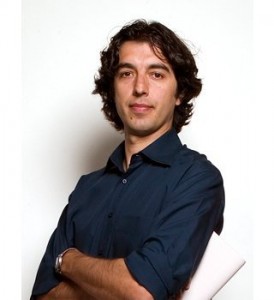 It was a eureka moment yesterday for scientists at CERN, the European Organisation for Nuclear Research. They announced that they’re confident (as confident as a scientist could be when charting new territory) that they have in fact, discovered what they call the God Particle. You know, the subatomic atom eggheads are saying was responsible for setting the Big Bang into motion!? (the actual moment of the creation of our universe, not the show). Actually the scientific name for it is the Higgs Boson, named for Peter Higgs, one of the physicists who proposed the idea of such a particle existing back in 1964. The God particle is just a great nickname, isn’t it? So anyway, to understand why this so-called discovery is so crucial, we have to understand the theory that it came from. And as much as I love the idea of SCIENCE, I’m nobody’s physicist, so I’ve brought over some friends to explain things to us in the simplest of layman’s terms — a Higgs Boson for Dummies, as it were.
It was a eureka moment yesterday for scientists at CERN, the European Organisation for Nuclear Research. They announced that they’re confident (as confident as a scientist could be when charting new territory) that they have in fact, discovered what they call the God Particle. You know, the subatomic atom eggheads are saying was responsible for setting the Big Bang into motion!? (the actual moment of the creation of our universe, not the show). Actually the scientific name for it is the Higgs Boson, named for Peter Higgs, one of the physicists who proposed the idea of such a particle existing back in 1964. The God particle is just a great nickname, isn’t it? So anyway, to understand why this so-called discovery is so crucial, we have to understand the theory that it came from. And as much as I love the idea of SCIENCE, I’m nobody’s physicist, so I’ve brought over some friends to explain things to us in the simplest of layman’s terms — a Higgs Boson for Dummies, as it were.
Q: So I keep reading about this physics guy named Higgs Boson. Who is he, and why is he in the news all of a sudden?
A: It’s not a he.
Q: It’s a she?
A: No, it’s an it.
Q: So… it’s not a person…?
A: Correct. It’s a particle.
Q: A particle? What’s that?
A: A basic building block of stuff. Like an electron.
Q: Or like an atom?
A: Well, an atom is made up of other, smaller particles. But yes. Sort of like an atom.
Q: And how does this Higgs thing fit into that?
A: About 40 years ago, physicists tried to put together a theory that would explain why stuff behaves the way it does. They called it the Standard Model. One of the things they imagined would need to be part of that Standard Model was a boson, a type of particle that would allow other particles to do the kinds of things that particles do.
Q: And what do particles do?
A: They combine together. They form things. Bosons help slow particles down from their natural super-speed and let them join up with other particles and stick together.
Q: Okay…
A: But for all of these years, it’s only been a theory. This guy named Higgs had proposed that these bosons exist to do this stuff, but no one had ever seen them. Until last Tuesday, when a machine in Switzerland designed to test the predictions of physicists found something that would be consistent with the existence of the Higgs boson.
Q: So they saw one?
A: They think they saw one. They saw something that could very well be a Higgs boson.
Q: Why aren’t they sure?
A: The Higgs boson is an unstable particle. As soon as you see it, it’s gone.
Q: And why is this exciting?
A: Because it would mean that some crazy theory a bunch of physicists came up with 50 years ago to explain the way the world works might actually be true.
Q: Thanks. So you’re sure Higgs Boson isn’t just some guy’s name?
A: Yes. Almost 100% sure.
Q: Cool.
A: Cool. h/t The Mind Hut
Tu sabe? Muy Bueno! ♦
 Well, New York City has finally made its long-awaited push against its organized labor factions by attacking certain union worker’s 401K’s.
Well, New York City has finally made its long-awaited push against its organized labor factions by attacking certain union worker’s 401K’s.
The Cultural Institutions Retirement System or CIRS , was formulated as an arrangement dating back to 1962, where the city pays into a pension system that covers dozens of day care centers with city contracts as well as dozens of cultural institutions to the tune of $17 million per fiscal year. Typically, employees covered by CIRS are in unionized positions, like security guards, daycare workers or gardeners, with a portion of their salaries paid for by the city.
What The Execs Are Saying…
Mark Page, the City’s Budget Director— he’s saying he believes that city day care centers and cultural institutions such as the The Museum of Natural History, the Brooklyn Museum, and Studio Museum in Harlem may be inaccurately reporting the number of employees that are actually covered by CIRS, and has directed the city’s budget office to temporarily suspend paying into the fund until further investigations are completed.
“There is a bunch of money that we have paid for over the years that has been, I guess, nice for those enterprises but not very nice for our taxpayers and what we have actually gotten for our money,” said Page.
Lauren Passalacqua, a spokeswoman for the mayor’s office — She’s saying that the budget director’s office has “detected potential anomalies in the data provided by these nonprofits related to the payments the city was making for them to CIRS.” In other words the numbers aren’t adding up.
“The city has not paid the CIRS bill this fiscal year, and the city is currently conducting a review of payments made to CIRS on behalf of these nonprofits to ensure that proper and accurate bookkeeping records were maintained,” Passalacqua says .
Raglan George Jr., executive director of DC 1707 (home care, child care, foster care,workers) — Says that the Budget Director has failed to consider the pension payments of about 1,200 workers who were let go last year because the city had introduced a new early childhood education program.
“When they made that decision they never considered the impact on the pensions,” he said of the city officials.
Richard Koski, Executive Director of CIRS — Right now, he’s saying that he could not discuss the issue and does not have full details of the city’s concerns, but added,
“We’ve been around for 50 years, and I think we do a really good job for the folks who work there,”
What The Execs Want Us To Believe…
Ms. Passalacqua stated that once the Office of Management and Budget completes its review of the system, she expects that whatever money the city owes the institutions would be paid into the retirement plan.
Mr. George remarked that the pension system is well-covered, and that a temporary delay in the city’s payment would not affect people currently enjoying their hard-earned pensions.
Mr. Koski says that over 20,000 people, both active and retired, and about 50 cultural institutions are covered under CIRS. He says the plan has been around for 50 years thinks the system has done a really good job so far.
The “F” Bomb!…
Mr. Page, in a letter this year to the commissioners for the city’s Cultural Affairs Department and the Administration for Children’s Services, wrote that the city’s overall review of the pension plans seems to show that the cultural and day care employees working under a collective bargaining agreement (read: union) were receiving “benefits greater than those afforded to city employees.” In other words making more money that non-unionized workers. And there’s more…
The letter said that when the current collective bargaining agreement ends on June 30th of this year, the city would finance pensions only at the same level as non-union city employees regardless of whether or not a new collective bargaining agreement is settled on, and that the city would no longer subsidize benefits like matching the 401(k) contributions of employees.
And that pilgrims, is how the middle class working stiff gets #*”@%!!…again! ♦
Things that make me go “Hmmm”… Does buying bigger, firmer, perkier boobs make you more womanly? I mean, I know you probably feel you look more womanly, but is that the same as actually becoming more womanly?…especially when they’re implants? Do men get off on fondling fake boobs as much as they do real boobs? And are they Boobs if they do? Where did the word ‘boobs’ come from anyway and why is it associated with “dumbness”? Do women lose a certain amount of sensitivity after boob surgery? Is it worth it if they do? And wasn’t there a ban on boob implants due to their leaking, for godsakes!!! These are just some of the questions that come to mind when I see Before/After Boobie Surgery pics. And one more thing…are Hollywood male entertainers implanting things into themselves at record numbers as their female counterparts? Hmmm… ♦
 Dr. Valter Longo is the Director of the Longevity Institute in Los Angeles Cali. (where else?), as well as professor of Gerontology and Biological Sciences there. His life is devoted to the longevity of, well Life! How incredibly kool and sexy huh?! So, Dr Longo’s research has found that by deleting two genes of yeast cells — yeast commonly used by bakers and beer brewers — and putting it on a calorie-restricted diet, he was able to extend the lifespan of that same common yeast cell to 10 weeks instead of its dying at its usual maximum age of just one week! The study was published in the journal Public Library of Science Genetics.
Dr. Valter Longo is the Director of the Longevity Institute in Los Angeles Cali. (where else?), as well as professor of Gerontology and Biological Sciences there. His life is devoted to the longevity of, well Life! How incredibly kool and sexy huh?! So, Dr Longo’s research has found that by deleting two genes of yeast cells — yeast commonly used by bakers and beer brewers — and putting it on a calorie-restricted diet, he was able to extend the lifespan of that same common yeast cell to 10 weeks instead of its dying at its usual maximum age of just one week! The study was published in the journal Public Library of Science Genetics.
“So what Amy” you say? Well–while not the discovery of the elusive ‘Fountain of Youth’, the study and its application can quite easily be adapted to the Human genome. People!
“We’re setting the foundation for reprogramming healthy life. If we can find out how the longevity mechanism works, it can be applied to every cell in every living organism,” Longo says. “We’re very, very far from making a person live to 800 years of age. I don’t think it’s going to be very complicated to get to 120 and remain healthy, but at a certain point I think it will be possible to get people to live to 800. I don’t think there is an upper limit to the life of any organism.”
Thanks Doc, but personally I’ll settle for a sexy, feisty 120 years any day! And maybe you could look me up too, if you’re still around. ♦
Later pilgrims…









